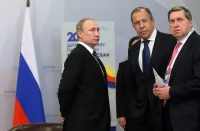Since the collapse of the USSR America has towered above the world like a lone tower. This strategic landscape looks uncommon and unnatural. Geopolitics is looks hard for a counterpoise that will get done with a challenge of the unipolar world. At that, analysts most frequently turn their eyes to the Shanghai Cooperation Organization (SCO).
The fact that draws the most attention is that the SCO contours coincide with the core of the former socialistic camp, including the two main Red capitals — Moscow and Beijing. As long as it was communism that rivaled Atlantism during the recent Cold War, revanchist parallels occur to us the first. Alarmed winners look at the SCO with apprehensions, losers — with a hope in their eyes.
Yet, we can hardly dub the SCO a reincarnation of the socialistic camp. First of all, since then substantial ideological difference between the key centers of the Red world emerged. While loyalty to the communist ideals is constantly reaffirmed at the Tiananmen Square, contemporary Kremlin holds a quite critical stance towards the Marxist past. Second of all, even during the age of ideological consensus, steady Moscow-Beijing axis has never been established. Before our parents had the time to learn the song «Russians and Chinese are brothers forever» during their Young Pioneer youth relations between the two great powers rapidly turned hostile from fraternal. Then Young Pioneers of Blagoveshchensk had to volens-nolens learn quite different slogans, which they heard from the opposite bank of Amur: «Good morning, dear Soviet comrades, temporarily living at the Chinese territories!»
A paradoxical hypothesis comes to mind: loss of the ideological similarity between Russian and China served the purpose of diplomatic approach. Far back into the past Solzhenitsyn prophesied that in his «Letter to the leaders of the Soviet Union»: he claimed that the Third World War is ripening because of the debate over the right of Communist primogeniture. Leave the «passing Red banner» to Chinese and the conflict will become much less tense.
Today the dispute over the purity of the «almighty and true teaching» is not topical anymore; conflict of the two greatest Asian powers has largely been settled. Yet, the absence of a conflict is not an invitation for an alliance still. What actually brings the SCO members together, while even the common goal of liberation of the global proletariat hasn’t led to the steady linkup of Moscow and Beijing? Does this alliance have global prospects, capable of changing the geopolitical scenery of the planet?
Nominally, the SCO brought up the banner of the fight against terrorism. In fact, the increased activity of Islamic extremists in the Central Asia sent the primary impulse for unification. The hotbed of tensions threatened to cause metastases in Xingjiang and the Muslim regions of Russia. That caused Beijing and Moscow (along with the secular governments of the Middle Asian republics) to show some joint care of the security matters.
Yet, no one actually believes the counter-action to terrorism to be a consolidating idea of the SCO. At least, the organization participants stand aside of such ardent fighter against terrorism as the USA and even contribute to the minimization of American presence in Central Asia.
There’s even less faith reserved for the economic premises of the union. Mutual commodity exchange of the organization members is still trifling. Actually, judging by the intensity of commercial ties, Beijing has much more grounds to side Washington, and Moscow is better ally with Berlin.
We may hardly talk about some global goals, adherence to some planetary mission of the SCO. Partners haven’t come up with such mission and it is absent from their political credo. Dream about the word-wide triumph of communists sunk into oblivion, while the dream of the triumph of democracy is a prerogative of a quite different bloc. Both Beijing and Moscow (let alone Astana, Tashkent, etc.) set quite cautious geopolitical goals instead and the very character of the bloc is still quite vague. It doesn’t resemble an alliance of direct actions, but rather a counseling council.
Yet the global response to the existence of the SCO undoubtedly exceeds the counseling scale. This response is caused by the global expectations, and what causes them?
Mackinder’s Heartland — core territory in the middle of Eurasian continent, heart of the world — instantly occurs to every person acquainted with the basics of the geopolitics after as much as a glance to the SCO map. A mystic aura surrounds the Heartland according to the philosophy of Halford Mackinder. «Who rules the Heartland commands the World Island; who rules the World Island commands the World»
Such endowment of Heartland with a mystical force clearly reflects an ancient terror of antique men before Huns, who came from the depths of the continent, although the last years of global history gave much more grounds for the Old-Testament-like fear of the Philistines — «people of the sea». All of that, however, are mere emotions, dark memory of humanity. But the very idea of contrasting the «people of sea» to the «people of land» is not entirely without a certain sense. It is not an all-embracing sense, but the one that plays an important role in the destiny of a planet anyway.
We may give several definitions to the Heartland. The first, the classical one is related to the core territory of the inner Eurasian flow plus the basin of the Arctic Ocean (i.e. Heartland stretches over the territories that lack the exits to the navigable seas). Thus, «people of the land» were simply cut off the world ocean, which not only meant them being geographically down-and-out, but also stipulates an extra protection from the outer invasions.
Having looked at the isotherm map closer, we may discover that this core space almost precisely matches the zone of below-zero winter temperatures. Full-blown continental climate complicates the economic mastering of Heartland, which, from one hand, slowed the economic development of the «heart land» nations down, but, from the other hand, kept the vast natural resources intact. Given such approach, «heart land» sounds similar to the «hard land».
It is worth mentioning that both definitions of Heartland — hydrographic and isothermal ones — are fully applicable to contemporary Russia and Central Asian republics; as for China, it may be applied only to its northern-western half: Xingjiang, Tibet, Inner Mongolia. Core of the Chinese civilization emerged in the basins of Chang Jiang and Hwang Ho, which feature mild climate, directly adjoin the sea (therefore, according to Mackinder classification, it is a typical Rimland, arc-like land of the coastal crescent).
However, unlike the majority of other Rimland inhabitants, Chinese are clearly «people of the land». China was built as a «building with an inner yard», rather than a «house facing the sea». Throughout millenniums, Chinese domestic market played much greater role than the ties with the overseas partners. This is mostly explained with the huge capacity of the local market, incomparable to the markets of the nearest neighbors. Chinese human potential has reached the critical mass as far back as before Christ, allowing to organize a full-fledged division of labor even within the framework of autarchy. Scale of Chinese economy was incomparable to the economies of all the overseas partners altogether. India might have become the only comparable contractor for it, but the maritime dealings with it were complicated with an inconvenient configuration of the Malay Peninsula.
To be continued…
Source: WIN.RU














Pingback: What Do Bear and Tiger Have In Common? (II) | Oriental Review